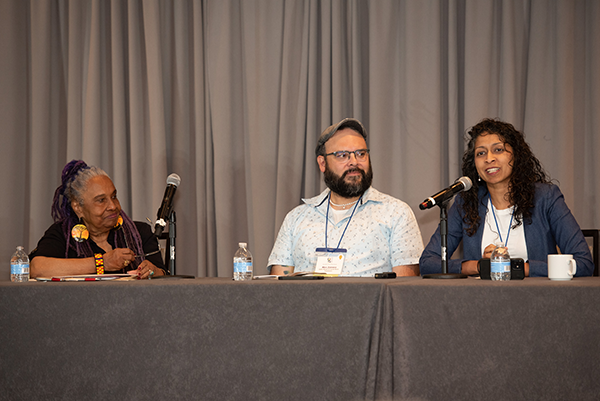The Structure of a Board: How Board Structure Impacts Regulatory Administration
Social work boards came together at the ASWB Education Meeting in Arlington, Virginia, May 3–4 to discuss a variety of issues currently confronting the profession. A panel discussion revealed how board structure can affect communication channels, regulation, and outcomes.

Panelists included Denitha Breau, RN, MSN, MBA, Registrar and CEO, Ontario College of Social Workers and Social Service Workers; Velva Taylor Spriggs, MSW, LISW, District of Columbia Board of Social Work; and Alex Zamora, Ph.D., LCSW, Idaho Board of Social Work Examiners.
They discussed challenges such as board member time constraints, emerging technology, communication styles, board turnover, and regulatory differences across jurisdictions.
Breau stated that, with board members being pulled in many directions, one of her priorities is keeping the board at the strategy level. “We need to ensure that the board is on the balcony and not in the weeds,” she said. Communication is also paramount, with staff sometimes playing referee. “A well-functioning board is able to trust and build relationships where they’re able to balance their opinions with each other,” she continued.
A well-functioning board is able to trust and build relationships where they’re able to balance their opinions with each other,
With a constituency of 29,000 registrants and a staff of just under 50, Breau noted that it’s important to stay focused on strategy. Many issues come up that create a lot of “noise,” but limited resources make it crucial to remain mission focused.
Velva Taylor Spriggs, MSW, LISW experiences unique circumstances in her role with the District of Columbia Board of Social Work, which is composed of five members with all four areas of licensure represented. “We have all of the state-level obligations with none of the privileges of statehood,” she said, noting that the District has advocated to become a state for years without success. “There have been many proposals to eliminate licensing altogether. We have certainly fought this.”
Despite the unique layers of government in the District, Spriggs said that the board has been able to maintain independent decision-making authority with laws and regulations. With a lean board structure of only five seats, and one current vacancy, she noted that it can be a challenge to reach a quorum at times.
Alex Zamora, Ph.D., LCSW, with the Idaho Board of Social Workers, is in his fifth year on his board. “Our board structure is the playing field,” he said. “We have to be able to navigate and facilitate the process.” The board, though autonomous, sits under an executive agency which was restructured with the election of a new governor. Working with the Division of Occupational and Professional Licenses (DOPL), the board was charged with reducing rules by 20%, a process that took a year. Ultimately, Zamora noted, this goal was met by eliminating some rules and improving upon others.
Questions and challenges emerged regarding budget, authority, and oversight. “There have been lots of growing pains” with the new structure, Zamora stated. “The process was super interesting, and I think the board will be better because of it.”
Audience members raised a variety of questions for the panel, highlighting the many differences that exist among each jurisdiction’s administration of social work regulation.
A major theme both in the panel discussions and in questions from the audience was communication. The differences among paid staff, volunteer boards, and government entities can lead to varying points of view. The solution is often talking through the barriers and finding common ground. “We generally keep talking until we work through our differences,” Spriggs said.
Sam Rosario from New Hampshire offered his advice about streamlining the application process. So that his board can concentrate their focus on the more complex applications, his organization identifies the standing orders, standard applications, or supervision agreements, and allows the administrators to process those.
Questions arose about term limits for board members, including years of service, re-appointments, and how term limits might impact a board’s effectiveness.
Panelists and audience members shared that their boards had anywhere from one-year to five-year terms, some with the ability to be reappointed and others without. “It takes several months to become familiar with the process,” Spriggs said, yet some only serve one year after just beginning to get comfortable with the role.
“Every year, we’re switching out two to five council members,” said Breau, meaning that the entire energy and dynamic changes over in each council year. “Administrative staff have to ensure that we’re bringing that history to the table,” she said.
Overall, the session highlighted the fact that there are many ways to build and manage a board, each with its own strengths and challenges. Staff are vital to maintain consistency, while former board members can be helpful as advisors when boards find themselves with a majority of newer members.

